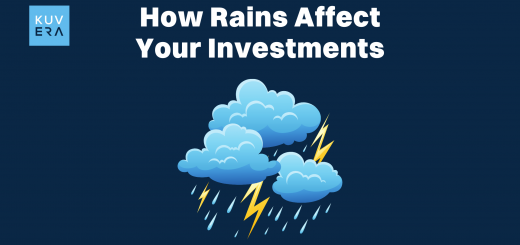The Indian stock exchange is a large marketplace for over 1900 companies. Here, each investor is searching for one or more criteria to compare these equities and choose their optimal wager. This is when benchmarks such as the Nifty and Sensex become relevant. When attempting to predict the general direction of the market, we examine the market index. All of the world’s leading stock exchanges have indices that represent market behaviour or investor sentiment. When regular investors seek a sense of the direction of the market, they look to the indices. A bullish or bearish trend is shown by an index’s upward or downward movement, respectively.
Nifty and Sensex are significant stock indices in India that indicate or represent the health of the stock market. Sensex is the oldest market index for stocks, and it contains shares from the top 30 companies listed on the Bombay Stock Exchange (BSE), which account for around 45 per cent of the index’s free-float market capitalisation. Nifty, on the other hand, is comprised of the top 50 companies listed on the National Stock Exchange (NSE), which account for approximately 62% of the index’s free-float market capitalization.
What Is Index?
An index is a statistical tool used to determine the performance of the best-performing equities on the Indian stock market. These market indexes evaluate the worth of companies based on a variety of characteristics, including industry, market capitalization, price points, etc. These indices are utilised by investors to gauge a particular market segment or the market as a whole. These indices influence the market value of equities and are therefore regarded as the barometer of the Indian stock exchange. Based on the premise of selecting the best, an index picks the top-performing stocks for each market category based on the trends and places them in a single, homogenous basket. The two most popular indexes in India are the Nifty and SENSEX.
What Is Sensex?
Mr Deepak Mohoni, a stock market analyst, derived Sensex from the terms Sensitive and Index. The Sensex debuted on January 1, 1986. This is a BSE or Bombay Stock Exchange index. The 30 firms that make up the Sensex are selected based on their liquidity, market capitalization, revenue, and diversification. In addition, a company must be listed on BSE to be included in the Sensex.
People view it as a gauge of market performance and a reflection of India’s economy, as it is one of India’s oldest indicators. It is used as a benchmark to measure the growth and development of the Indian economy and industry and to comprehend the trend of the stock market. Sensex consists of the 30 largest stocks. The index’s value is dependent on the price changes of the underlying securities. A rise in the value of the Sensex is attributable to an increase in the prices of the majority of equities. While a decrease in the index’s value is attributable to a decline in the prices of the majority of the underlying securities.
On April 18, 1992, the BSE Sensex fell 12.7%, its largest drop ever, following the disclosure of a scheme in which a renowned broker diverted funds from the public banking sector to invest in stocks. Since India’s economic liberalisation in 1991, the index has enjoyed substantial development. The biggest improvements were in the twenty-first century when it increased from about 5,000 in the early years of 2000 to more than 42,000 in January 2020. This is primarily due to India’s booming economy, which has been expanding for years at one of the fastest rates in the world.
The expansion of India’s economy is largely attributable to the rise of the country’s middle class, and vice versa. By 2030, about 80% of the nation’s families will have a middle income, up from roughly 50% in 2019. The middle class is a significant force in driving consumer demand. As of August 31, 2021, the index had an average total market capitalization of 3.71 trillion rupees.
The top five players of the index were as follows:
The development of the Indian economy has shaped and altered Sensex’s methodology. Initially, it was computed based on market capitalization, but in September 2003, the approach was changed to a free-float capitalization method. This offered a weighting for a company’s effect on the index. The index measures a company’s float rather than its outstanding shares, thus it excludes restricted stocks, such as those held by corporate insiders, that cannot be easily traded. Despite all of the modifications to the index’s methodology, its goals have remained the same.
The S&P BSE index Committee selects its components based on the criteria mentioned below:
- The company should be listed on the BSE in India.
- The company ought to be a large-to-mega-cap company.
- The company’s stocks should be liquid.
- Companies should create income from their core operations.
- The company should maintain the sector’s equilibrium in accordance with the Indian equities market.
Between 1986 and 2021, the Sensex grew at a compounded rate of nearly 14% per year. This rise indicates the enormous growth of the Indian economy over that time period, specifically the expansion of the middle class in that country. In the midst of the coronavirus health crisis in March 2020, the Sensex fell by about 40 per cent but recovered impressively for the remainder of the year.
How To Calculate Sensex?
The BSE Sensex is calculated using the Free Float Market Capitalization technique. Previously, Sensex employed the market capitalization weighting approach. Since September 1, 2003, however, the free-float market capitalisation technique has been utilised. After choosing 30 stocks for the index, the free float market capitalization method is used to compute the index’s value.
The initial stage is to determine the free float market capitalisation of the index’s 30 companies.
Market Capitalization * FreeFloat Factor = FreeFloat Market Capitalization
The free Float factor is the proportion of a company’s issued shares that are readily available for trading by the general public. This also refers to the total number of outstanding firm shares. Also excluded are the shares issued to promoters, the government, etc. that are not available for trade on the market. Market capitalization is the company’s market value.
Market capitalization equals share price multiplied by the number of outstanding shares. After determining the free float market capitalisation. The value of the BSE Sensex can be determined using the formula provided below.
BSE Sensex computation:
Value of Sensex = (Total free-float market capitalization/ Base market capitalization) * Base period index value.
1978-79 is the base period (year) for Sensex calculations. The index’s base value is 100. Using the above technique, the value of the BSE Sensex may be determined.
What Is Nifty?
The term Nifty is derived from the combination of two words: “National Stock Exchange” and “fifty.” The acronym stands for the National Stock Exchange Fifty. It is a selection of the 50 best-performing equities in the index that are actively traded. Currently, 50 stocks are trading on the Nifty. Nifty is sometimes referred to as Nifty50 and CNX Nifty.
The CNX Nifty began trading on April 22, 1996. The base period for the CNX Nifty index is November 3, 1995, the date that the National Stock Exchange Equity Market Segment completed one year of operations.
The index is composed of 50 distinct companies that trade on India’s NSE and is calculated daily in real-time using a free-float market capitalization technique. The index is rebalanced every six months, on January 31st and July 31st of each year. The index has several variations, including the Nifty 50 USD, the Nifty 50 Total Returns Index, and the Nifty 50 Dividend Points Index. India Index Service & Products Limited owns and manages the property (IISL). IISL is an Indian corporation that specialises in indexes as its main product. It offers index funds, index futures and options, equity futures and options, etc.
The following are the qualifying requirements for companies to be included in the Nifty Index:
- The organisation must be listed on the National Stock Exchange. It must be a company based in India.
- The shares of the corporation must be very liquid. The measure of liquidity is the average impact cost. Impact cost is the trading price of a single share relative to the weight of the index to the market capitalization of the company. The company’s impact cost should be less than or equal to 0.50% for six months. Otherwise, it should be lower with 90% of observations made on an Rs.10 crore portfolio.
- For the previous six months, the company’s trading frequency should have been 100 per cent.
- The corporation should have a market capitalisation that fluctuates freely on average. This should be 1.5 times larger than the index’s smallest business.
- Shares of corporations with DVR or Differential Voting Rights are also eligible for inclusion in the Nifty 50 Index.
In addition to the periodic routine, the index undergoes a reconstitution when the company experiences certain events, such as spin-offs, mergers or acquisitions, suspensions, or mandatory delisting. In addition, Nifty performs periodic audits of the companies to monitor their compliance with legislation.
The companies must also adhere to the Securities and Exchange Board of India’s directives (SEBI). If not, the companies could be removed from the indices.
How To Calculate Nifty?
Nifty 50 uses the free float market capitalization weighted technique. The index price reflects the entire market value of all equities included in the index relative to the base period on November 3, 1995.
Market Capitalization = Current Market Price * Outstanding Shares
Free Float Market Capitalisation = Outstanding Shares * Price * Investable Weight Factors
Index Value = (Current Market Value / Base Market Capital) * Nifty Base Index Value (1000)
The aggregate market capitalisation of each scrip in the index at the base period is the base market capitalisation of the index. During the base period, market capitalisation is equivalent to the base Index value of 1000.
Investible weight factors are the units of a business’s floating stock that are open for trading and are not held by entities with a strategic interest in the company. The IWF for each company in the index is computed based on the public holdings reported in the quarterly shareholding pattern submitted with the stock exchanges.
Difference Between Sensex and Nifty?
| S.No. | Nifty | Sensex |
| 1. | Also known as Nifty 50 and S&P CNX Fifty | Also known as S&P BSE Sensex |
| 2. | Nifty is owned and managed by India Index and Services Products Limited (IISL), an NSE Subsidiary. | Sensex is owned by the Bombay Stock Exchange (BSE). |
| 3. | It is a well-diversified 50 companies index reflecting overall market conditions. These are the top 50 companies listed on NSE. | It is a well-diversified 30 companies index reflecting overall market conditions. These are the top 30 companies listed on NSE. |
| 4. | Nifty covers 24 sectors of the Indian economy. | Sensex covers 13 sectors of the Indian economy. |
| 5. | Base Number: 1000 | Base Number: 100 |
| 6. | Base Year: 3/11/1995 | Base Year: 1978-1979 |
Which Is Better, NSE or BSE?
NSE and BSE are Indian stock exchanges. India’s oldest stock exchange is the Bombay Stock Exchange (BSE). Comparatively, the National Stock Exchange (NSE) is India’s largest stock exchange. NSE has higher trading volumes than BSE. In other words, there are more buyers and sellers on the NSE.
Moreover, NSE has greater liquidity. It facilitates trading and expands investors’ opportunities to convert stocks to cash. On the other hand, BSE is an enormous stock pool. There are approximately 5000 companies listed on BSE. On the other hand, there are approximately 2000 companies listed on NSE. In addition, all equities listed on the NSE are also listed on the BSE. Furthermore, NSE has a monopoly in the derivatives market with Nifty. NSE Nifty and Bank Nifty are the most actively traded indices.
Therefore, BSE is more suited for novices, whereas traders and experienced investors choose NSE. In addition, BSE is the optimal option for an investor seeking to invest in fresh companies. For traders that deal in futures and options, however, derivatives NSE is the optimal solution.
Why Market Indices Are Important?
The primary purpose of indexes is to facilitate trading for investors. Imagine a stock market without such classifications, where all the stocks listed on the exchanges are accessible for purchase, but you do not know which stock has a larger market capitalization, which stocks have lower value, and which stocks are “superior.” All investors will be wandering around like hunters without heads. Here, the significance of stock market indices becomes apparent. By organising them and increasing their visibility, they make trading more convenient.
Having indices is a crucial component of stock market investments for the following reasons:
- Grouping/Sorting
As stated previously, having all the companies grouped together in an organised manner and selected according to a particular strategy, such as free float market-capitalization in this case, makes it easy to see the top stocks in one location. Let’s consider Sensex as an example. S&P BSE Sensex is a collection of 30 equities, whereas S&P BSE 100 and S&P BSE 500 are collections of 100 and 500 stocks, respectively. These indices enable you to view the top small-cap companies at one place.
On occasion, you may choose to examine the performance of a specific industry. For instance, in the current climate, where a pandemic has grabbed the entire planet and financial markets are falling, you may be interested in the health sector’s performance. In the absence of indexes, each pharmaceutical company would have to be tracked down, compiled, and calculated manually. However, grouped indices such as Nifty Pharma and S&P BSE Healthcare perform this function automatically.
- Assessing stock and market performance
Sorting not only helps you select stocks but also leads you throughout the process. Having ordered indices makes it easier to find the solutions to if a stock is performing better than the benchmark stock market index if a particular stock is riskier than the others if it is performing better or worse than the other stocks included in the index if it has performed better or worse than the other stocks in its sector, and a number of other questions. Indices are an excellent tool to track the individual and comparative performance of stocks. Indices contain a wealth of information about equities. Price history, volume fluctuations, peer-to-peer comparisons, sector performance, volatility, and a sense of the market’s direction are all essential elements. If a group of the 30 or 50 top Companies exhibits an uptrend or a downtrend, it tells volumes about the state of the stock market as a whole.
FAQs
-
What are the factors affecting stock market indexes?
The Index trend is influenced by inflation rate, interest rate fluctuation, economic conditions, and foreign influence, among other variables.
-
Which is better Nifty or Sensex?
The two most popular stock market indices, Sensex and Nifty are extensively considered by investors. Consequently, the answer to this issue is contingent upon the requirements of the investor. Beginners and retail investors like the Sensex index, whilst traders and seasoned investors prefer the Nifty.
Interested in how we think about the markets?
Read more: Zen And The Art Of Investing
Watch/hear on YouTube:
Start investing through a platform that brings goal planning and investing to your fingertips. Visit Kuvera.in to discover Direct Plans and Fixed Deposits and start investing today.
#MutualFundSahiHai #KuveraSabseSahiHai!











